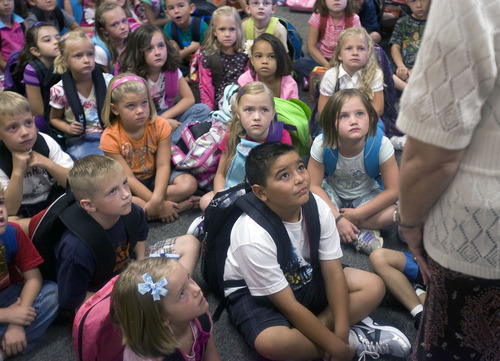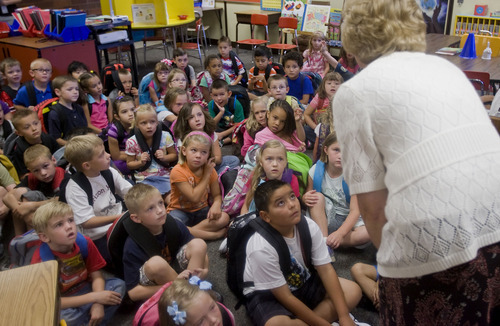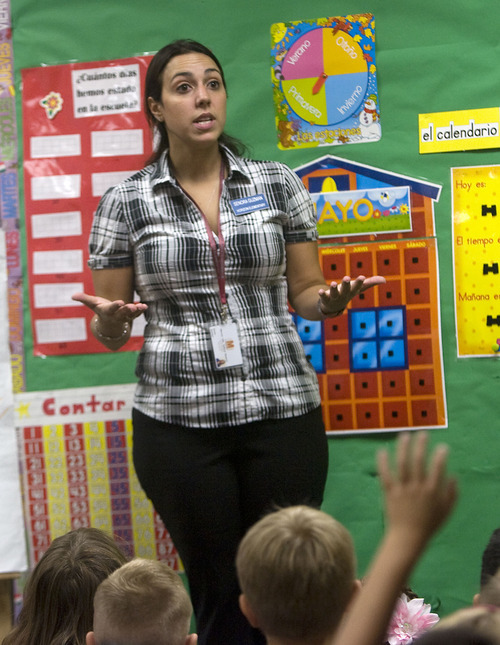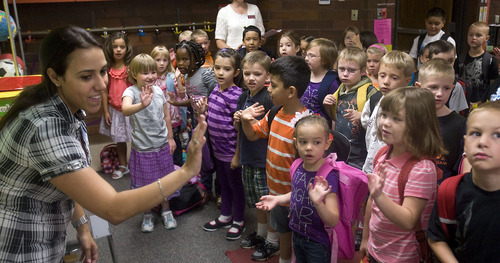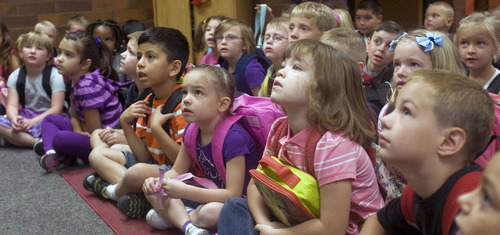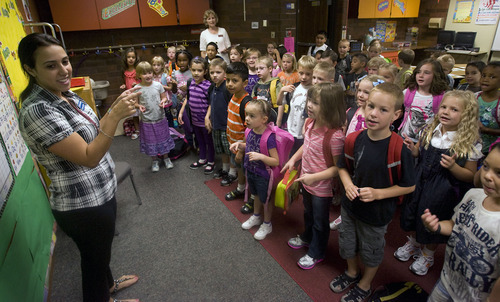This is an archived article that was published on sltrib.com in 2011, and information in the article may be outdated. It is provided only for personal research purposes and may not be reprinted.
Murray • The 6-year-olds began their day much like other first-graders across Utah on their first day of school this week.
They learned to use their indoor voices. They were told to listen. They were asked to raise their hands rather than blurt out stories and questions.
Then they went to a colorful classroom next door where they learned the rules all over again — in Spanish. For most of the students, it was the first time they had heard more than couple of words of the foreign language.
"Los ojos en la maestra," Horizon Elementary teacher Karina Guzman told the students, holding a finger up to her eyes and then pointing toward herself. Eyes on the teacher.
For many Utah students, the days of starting foreign language instruction slowly, in middle or high school, are over. Horizon Elementary in Murray is one of 57 schools — 16 more than last year — offering dual-immersion language classes often starting in first grade. Students spend half the day with an English-speaking teacher, and the other half with a teacher who speaks entirely in a foreign language — Spanish, French or Mandarin Chinese — focusing on various subjects in each language. By sixth grade, they're expected to be fluent in both languages.
"The reason why we're doing this during hard economic times is this is all about Utah's future," said Gregg Roberts, world languages and dual-immersion specialist at the state Office of Education. "We're going to have a generation of kids to come that will really put Utah on the map and bring businesses here because it really is about Utah's future economic survival."
State leaders hope to see 30,000 Utah students in 100 dual-immersion programs by 2015, Roberts said.
—
Kids cope • But for Guzman's first-graders Monday, it wasn't about the economy. Or global competitiveness. Or their future employment prospects.
It was about learning where to hang their hot-pink backpacks. About where to sit. And about getting used to a teacher asking them to do things in another language.
Guzman and her English-speaking counterpart, Linda Curtis, spent the first chunk of the day teaching the 58 first-graders together. Curtis explained rules and Guzman highlighted certain points in Spanish.
Then half the students took a short walk down the hall to Guzman's classroom.
They might as well have left the country, save for a U.S. flag hanging from the wall.
Guzman's room had all the markings of any first-grade classroom — a colorful bulletin board naming the months of the year, an upbeat song playing from a stereo and picture books lining the shelves — but all in Spanish.
Guzman, who grew up in Colombia, used repetition, facial expressions, pictures and gestures to illustrate her words, which often came faster than most adults with only a few years of high-school Spanish education might understand.
When she asked the students to stand, "levantarse," she lifted her arms in the air, looking at them. When she asked them to sit, "sentarse" she lowered them. For her first lesson, she asked students to draw their faces, after demonstrating at the board, naming each part of the face in Spanish and then asking the students to name each one back to her.
Some students — the very few who were native Spanish-speakers — answered her quickly. Others merely repeated her words. Some just sat silently.
But within a few minutes, all the first-graders were drawing their faces, without a word of English having ever passed Guzman's lips.
Guzman won't speak English to the students all year, and they'll be permitted to speak to her in English only until January, at which point they too will be expected to speak only Spanish in her classroom — a requirement many adults didn't face until they were in high school or college.
"If they know she'll speak English, they'll wait until she speaks English, and they're not going to learn as quickly," said Martha Kupferschmidt, Murray district director of teaching and learning and principal at Horizon up until this year. Kupferschmidt led the school during its first two years of the dual-immersion program.
—
Benefits • Kupferschmidt said the students in Horizon's dual-immersion classes show the same achievement levels as those in its regular classes. Research has shown immersion benefits students cognitively, allowing them to think more flexibly, and immersion students achieve as well or better than nonimmersion students on standardized tests of verbal and math skills given in English, according to the Center for Applied Linguistics, a Washington, D.C.-based nonprofit organization that works to improve communication through better understanding of language and culture.
"It's fabulous because the kids are like sponges. They're just soaking it up," said Tristin West, who taught Horizon's Spanish dual-immersion class last year and now works as the state's Spanish teaching specialist. "It gives them an opportunity to use their brains in a way they wouldn't have to otherwise. They have to ... make meaning out of things that are happening without understanding the words. It strengthens those skills."
Statewide, 17 elementary schools are teaching dual-immersion Mandarin, nine are teaching French, and 31 are teaching Spanish this year. Utah is home to a third of all Chinese elementary immersion programs in the country, Roberts said. The Utah program is funded with about $600,000 a year in state money, $300,000 from the National Security Agency, and $230,000 from the U.S. Department of Education. Also, China and France pay a number of their teachers to be here. Otherwise, Roberts said, the program doesn't cost school districts any more than it would normally, as they don't need more teachers to do it.
At Horizon, two of the school's first-grade classes are dual immersion, and there's a waiting list to enroll, as there has been since the program started three years ago. A dual-immersion third-grade classroom down the hall from Guzman's illustrates why.
In that room, the Spanish-speaking teacher used fewer pictures and gestures than in the first-grade classroom. Students raised their hands to answer her questions in Spanish.
"If you start when they're in kindergarten or first grade that's a great beginning," Guzman said, "because they learn really fast." —
How does dual immersion work?
Statewide, 57 elementary schools — 16 more than last year — offer dual-immersion language classes often starting in first grade. Students spend half the day with an English-speaking teacher, and the other half with a teacher who speaks entirely in Spanish, French or Mandarin Chinese, focusing on various subjects in each language.


